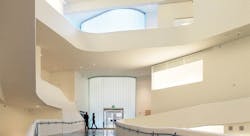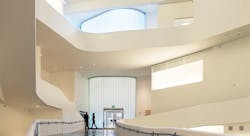Implementing natural light in your workspace isn’t always easy, especially in an existing building.
Bringing in the most daylight possible sounds like a good idea until it brings solar heat gain and glare with it, driving up your cooling-related energy consumption and potentially prompting occupants to cover the window in the name of avoiding disruptive glare.
Make sure your building is delivering the right amount of daylight in the right places with these three tips.
Deliver Quality over Quantity
The key to making sure occupants are happy with access to natural light is remembering that more daylight isn’t always better. An overabundance of light coming in leads to glare, hot spots and sharp shadow lines.
“A good daylighting strategy calls for bringing in a lot of diffused light and distributing it throughout the interior,” adds Donald Jayson, co-owner and senior vice president of Bendheim, a manufacturer of architectural glass. “The key word is diffused—no blinding glare, no hot spots and no sharp shadow lines. Maximizing the amount of glass on the facades isn’t always the solution. The site, building orientation, occupant wellbeing and the type of glass used are all critical components of daylighting design that should be weighted together.”
Daylighting in existing buildings requires a critical eye.
If you have curtainwall that needs to be replaced anyway, glazing that lets an adequate amount of light through but mitigates glare and solar heat gain is a smart purchase.
[Related: Glass Buildings Reflect Many Benefits]
Punched windows can deliver a significant amount of useful daylight too, but may require a different arrangement of furniture or retrofitting a daylight redirecting device to bounce the available light further into the core.
When you replace your windows, look at the visual light transmittance values of glazing products and choose the one that lets through the most quality light while still controlling glare and solar heat gain, recommends Clarke Morrison, senior consultant for Microdesk, an AEC services provider whose services include daylight modeling with BIM.
Eliminate Glare and Redirect Light
Glare not only makes computer screens difficult to read, it encourages occupants to close their blinds completely in the name of visual comfort, eliminating the benefits of daylight, Jayson explains.
Daylight strategies must be responsive to local climate, building orientation and interior organization.
For side daylighting, consider partitioning the fenestration by function, recommends Michael J. Holtz, founder and CEO of LightLouver, LLC, a manufacturer of a daylight distribution device. With this setup, upper glazing (above 7 feet) serves a daylighting function and the glazing below serves as the viewing zone.
The upper portion can be retrofitted with a daylight redirection element that reflects daylight toward the ceiling, whereas the lower portion should have a manual or automated shading or a blind system to control the incoming sunlight.
“Far too often, we see large expanses of glass with little ability to control the distribution of daylight or eliminate the glare associated with direct sunlight penetration,” Holtz explains. “This situation occurs in both new and existing commercial buildings. What’s essential to achieving a glare-free daylit space is to ensure that daylight is collected and redirected upward and deep into the space and that effective glare control is provided on the ‘view’ windows. This approach can be implemented in new and existing buildings by incorporating daylight redirecting devices in the top part of the window and lowering any existing blinds or shades.”
Arrange Interiors
If you’re already receiving as much usable daylight as you can through the window, consider a simple renovation to allow that light to flow further into the space. Open floor plans and careful attention to furniture placement let you avoid blocking the incoming light.
Translucent glass partitions and anti-glare finishes also help bounce light through the space without creating glare or hot spots, Jayson adds.
Two handpicked articles to read next:
About the Author
Janelle Penny
Editor-in-Chief at BUILDINGS
Janelle Penny has been with BUILDINGS since 2010. She is a two-time FOLIO: Eddie award winner who aims to deliver practical, actionable content for building owners and facilities professionals.


